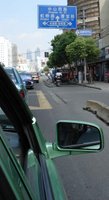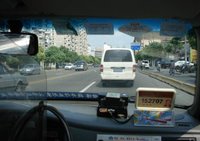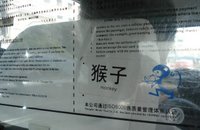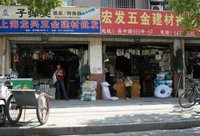



Free time= GO DOWNTOWN! I live 35 to 90 minutes from downtown depending on traffic, time of day, where downtown, and weather conditions. I give myself an hour. I often share a taxi with friends- a ride downtown costs about $10. Not bad for one hour in a taxi.
The very first mandarin words I learned were taxi survival phrases: yogwai-right- literally "small turn", zogwai- left- literally "big turn", eeghezou- straight. I have lived here close to eight weeks and I have finally figured out how to correctly pronounce the name of the district where I live. Zhudi- pronounce the zh like a J. I kept saying it over and over to the drivers. To no avail. With inner anger I pulled out the (now) dirty and well-used business card with my address written in Chinese to show them. This is demoralizing after a while- "I can't even tell this person how to take me home!" I was 4 and knew my own phone number and address. Here I barely know either- cell phone numbers are 11 digits and I have NO idea what mine is without my cheat sheet. Anyway, instead of pronouncing judee- all one word, I learned to say Jooooo- deeee. Long emphasis on the first part. Now they smile right away, step on the gas, and start jabbering at me in Mandarin, as if I understand.
Want to see inside a taxi? To the right of the dash, a photo id card- picture and name. Under the name are the stars. Zero to five. Zero stars means this person is fresh off the country bumpkin cart and has NO idea where downtown is, let alone how to get on the highway. BAD NEWS. Usually drivers have one or two, meaning they know streets and maybe have patience with foreigners. Three stars is great. They can interpret your judee and bring you home. Five stars exists, in theory. I have yet to see a four or five star driver. I will probably speak perfect Mandarin by the time I get to one of those!
TAXI orientation part 2: All taxis are Volkswagens. The Germans pretty much have the corner on the market. One taxi company also has "learn mandarin" info panels for the passenger to view. Unfortunately there is never the pin-yin, the Chinese word written in the Roman alphabet, just a picture and a Chinese character. This morning there was a picture of a monkey. GREAT! I thought, next time I see a zero star taxi driver I will call him a monkey. But... actually, I have no idea how to say "monkey" because there is no pin-yin written to show me how to pronounce the word. Therefore, I can not say the word but know how to recognize the character "monkey" in case I run into it somewhere... From a language teacher's point of view this is not an ideal acquisitional situation.
Taxi orientation part 3: Globalization and prep for Beijing Olympics 2008 are underway- many many street signs are in English. Signs on the highway and in town have both Chinese characters and pin-yin. Very cool. Another Mandarin lesson: Bei means north, while Nan means south. (Beijing is the north capital, while Nanjing used to be the South capital, jing means "capital city"). So, Shaanxi Bei Lu means North Shaanxi Street and Shaanxi Nan Lu means South Shaanxi Street. Cool!
Final street note: while sitting in traffic one has time to notice the sidelines. In these pics you can see the bike lane off to the side as well as some random stores. I have NO idea what these stores sell. Very often I walk by and say, "They sell fruit and cigarettes." Most often I see people sitting in their shops and I wonder if they know what they sell! Street-front property is not just for commerce but for sitting and watching the world drive by. If it is the morning, they sit in their pajamas. The topic of Chinese in their pajamas is a post for another day.
No comments:
Post a Comment